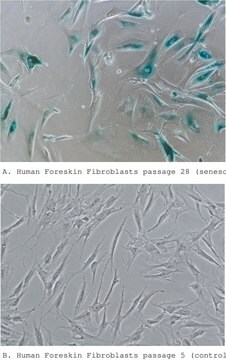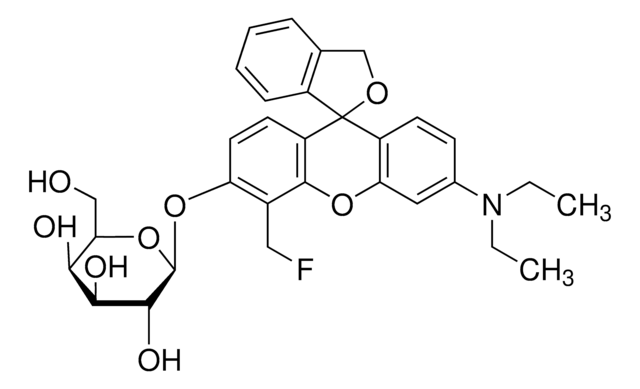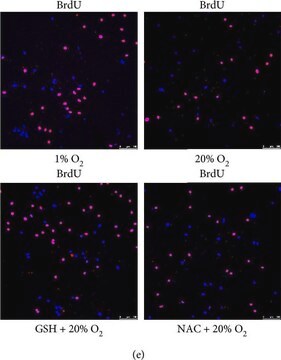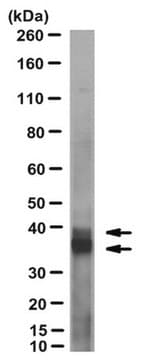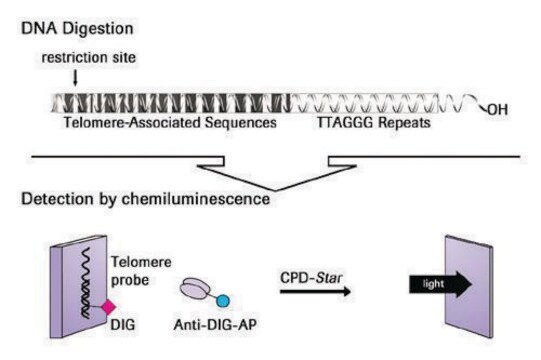KAA002
Cellular Senescence Assay
Cellular Senescence Assay Kits provide all the reagents required to efficiently detect SA-β-gal activity at pH 6.0 in cultured cells & tissue sections.
Sinônimo(s):
Senescence Detection Kit
About This Item
Produtos recomendados
Nível de qualidade
fabricante/nome comercial
Chemicon®
técnica(s)
cell based assay: suitable
método de detecção
colorimetric
Condições de expedição
wet ice
Descrição geral
It is generally believed that cellular senescence reflects some of the changes that occur during the aging of organisms, and senescent cells have been detected in vivo at sites of age-related pathology, such as benign hyperplastic prostate [4] and atherosclerotic lesions [5]. Recent studies have also provided convincing demonstrations of cellular senescence occurring in vivo in response to internally- and externally-induced stress signals [6,7]. In all of these studies, senescence was characterized by the appearance of senescence-associated β-galactosidase (SA-β-gal) activity, in common with the senescent phenotype in vitro.
Cellular senescence has become an increasingly important target in the development of novel therapeutics. Emerging data implicates senescence bypass in the development of cancer and suggests that senescence may represent a tumor suppressor mechanism. The demonstration that tumor cells can be induced to undergo replicative senescence following the introduction of negative cell-cycle regulators, anti-telomerase peptides, or drug treatment suggests that induction of senescence can be exploited as a basis for cancer therapy [8,9].
For Research Use Only; Not for use in diagnostic procedures
Test Principle:
As outlined above, a classic characteristic of the senescent phenotype is the induction of senescence-associated β-galactosidase (SA-β-gal) activity. SA-β-gal is present only in senescent cells, not in presenescent, quiescent, or proliferating cells. Chemicon′s Cellular Senescence Assay Kit provides all the reagents required to efficiently detect SA-β-gal activity at pH 6.0 in cultured cells and tissue sections. In this assay, SA-β-gal catalyzes the hydrolysis of X-gal, which results in the accumulation of a distinctive blue color in senescent cells. Each kit provides sufficient quantities of reagents to perform at least 50 assays in 35 mm wells.
Aplicação
Componentes
10X Staining Solution A: (Part No. 2004756) One 15 mL bottle
10X Staining Solution B: (Part No. 2004754) One 15 mL bottle
X-gal Solution: (Part No. 2004752) Two 1.5 mL vials
Armazenamento e estabilidade
Precautions:
Please refer to the Material Safety Data Sheet at www.chemicon.com for any necessary precautions.
Informações legais
Exoneração de responsabilidade
Palavra indicadora
Danger
Frases de perigo
Declarações de precaução
Classificações de perigo
Acute Tox. 4 Dermal - Acute Tox. 4 Inhalation - Acute Tox. 4 Oral - Aquatic Acute 1 - Aquatic Chronic 2 - Eye Dam. 1 - Flam. Liq. 3 - Repr. 1B - Resp. Sens. 1 - Skin Corr. 1B - Skin Sens. 1 - STOT SE 3
Órgãos-alvo
Respiratory system
Perigos de suplementos
Código de classe de armazenamento
3 - Flammable liquids
Ponto de fulgor (°F)
135.5 °F
Ponto de fulgor (°C)
57.5 °C
Certificados de análise (COA)
Busque Certificados de análise (COA) digitando o Número do Lote do produto. Os números de lote e remessa podem ser encontrados no rótulo de um produto após a palavra “Lot” ou “Batch”.
Já possui este produto?
Encontre a documentação dos produtos que você adquiriu recentemente na biblioteca de documentos.
Os clientes também visualizaram
Nossa equipe de cientistas tem experiência em todas as áreas de pesquisa, incluindo Life Sciences, ciência de materiais, síntese química, cromatografia, química analítica e muitas outras.
Entre em contato com a assistência técnica